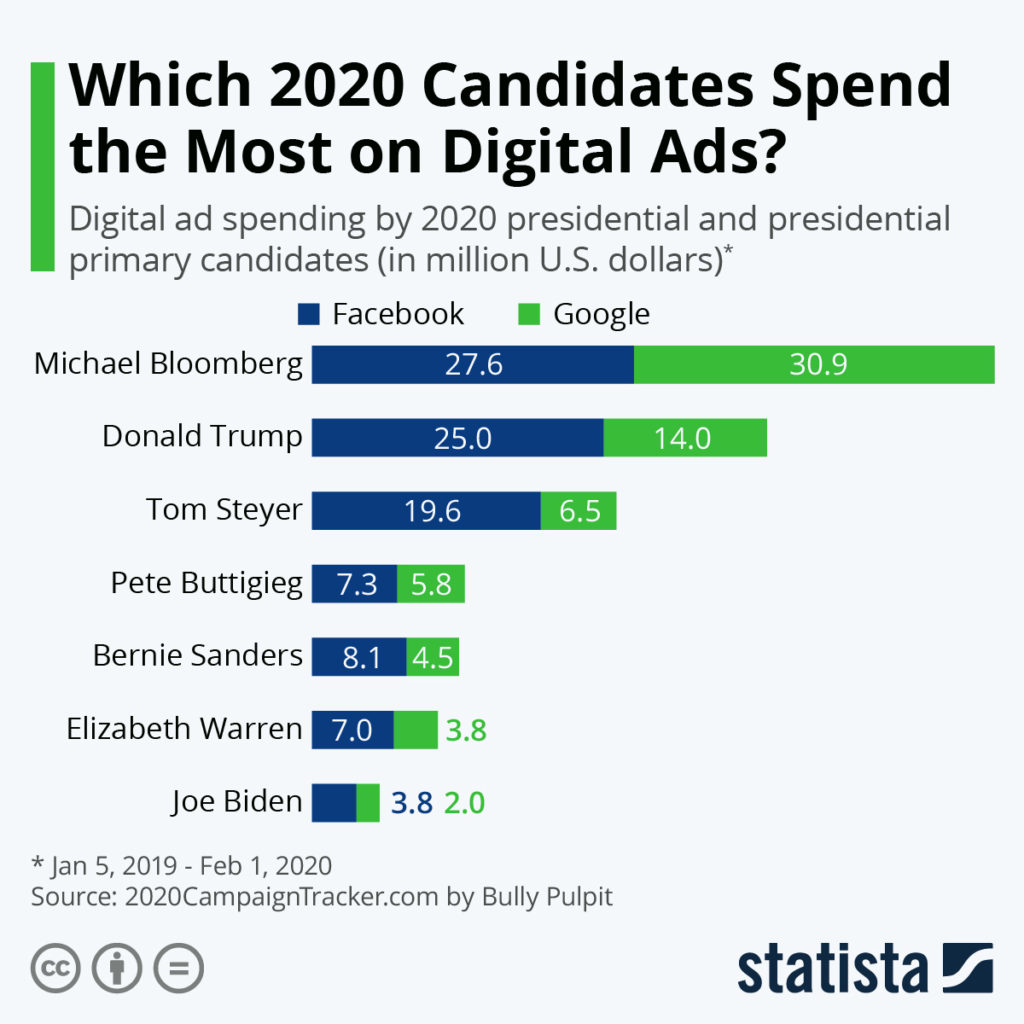
As primary season picks up steam, a constant conversation on the cable news outlets involves money – in many forms.
Campaign fundraising, political ad spending, and even where the money’s coming from – small donors, big corporations, or from billionaire candidates financing their own efforts – specifically Tom Steyer and Michael Bloomberg. You may recall Donald Trump’s original campaign in 2015 was self-funded. That didn’t last long, and now the President has joined most of the other candidates vying for his job, taking contributions from a wide range of organizations, PACs, and individuals.
These days, the morality of billionaires running for office is a heated topic of discussion, especially because of the way the Bloomberg campaign is  carpet bombing Super Tuesday states with TV spots in an effort to establish both name recognition and a seriousness of purpose that he can knock off the President. Not surprisingly, much of the whining is coming from his Democratic competitors, none of whom can keep pace with the former mayor of New York City’s spending spree.
carpet bombing Super Tuesday states with TV spots in an effort to establish both name recognition and a seriousness of purpose that he can knock off the President. Not surprisingly, much of the whining is coming from his Democratic competitors, none of whom can keep pace with the former mayor of New York City’s spending spree.
But the Bloomberg campaign is more than just about a seemingly unlimited advertising budget. A look at precisely how and where his strategists are spending his money tells us a lot about their plan to introduce their candidate to Americans who only have vague knowledge about who Bloomberg is and what he’s about.
Tonight, we’ll learn more, as Michael Bloomberg steps on the debate stage to mix it up with his fellow candidates, all of whom are peeved he’s bought his way into the conversation because of his rising poll numbers.
The lion’s share of Bloomberg’s spending is being funneled into TV stations and networks – in other words, a traditional campaign ad model. And in that regard, the only thing that differs from his competitors is the sheer poundage of his media buys. Chances are, if you watch any amount of TV, you’ve seen Bloomberg ads – not once, but multiple times.
But the former mayor appears to be looking beyond just pounding his message home on television. Social media has become a major conduit for connecting with prospective voters, and in that regard, he is now exceeding the Trump campaign’s ad spend in the social space. This recent chart from Statista illustrates part of Bloomberg’s thinking:

Still, advertising and publishing content on social media isn’t especially novel. As the chart shows, Bloomberg and Trump are the biggest spenders, but virtually all the candidates have jumped into Facebook, Instagram, and others.
And while content, messaging, engagement, and placement are all variables in any of the candidates’ campaigns, the Bloomberg team is taking it one step further, utilizing a “Purple Cow” approach to its social marketing.
What is “Purple Cow” marketing?
It’s a concept popularized by marketing guru Seth Godin back in 2002 – and it still holds up today. The book’s full title, “Purple Cow: Transform  Your Business By Being Remarkable” – speaks to the need to stand out, to create products that solve problems, and marketing that demands attention. At the time, we bought a copy of “Purple Cow” and gave them to every Jacobs Media clients that year as a holiday gift. The book was that good.
Your Business By Being Remarkable” – speaks to the need to stand out, to create products that solve problems, and marketing that demands attention. At the time, we bought a copy of “Purple Cow” and gave them to every Jacobs Media clients that year as a holiday gift. The book was that good.
As Godin explained, it’s like taking a drive in the country; the first cow you see might grab your attention. But 20 cow sightings later, and you’re ignoring the scenery.
But a purple cow? THAT would make you stop, look, wonder, and tell others.
One of my favorite lines in the book:
“In a crowded marketplace, fitting in is failing. In a busy marketplace, not standing out is the same as being invisible.”
As marketers, that’s precisely how we hope people think of our brands, especially in a competitive environment. That’s what Bloomberg is facing. That original crowd of Democratic Presidential wannabes has winnowed down, but there are still more than a half dozen candidates vying for our attention – including latecomer Michael Bloomberg.
So, what’s “purple” about his campaign?
A story in The Hill by Tal Axelrod reveals how the Bloomberg campaign has brought on a company called Meme 2020 that aggregates influential meme-makers on Instagram.
Some of Meme 2020’s portfolio content creators have already written fake ads in the voice of New York City’s ex-mayor. They are funny, attention-getting, and attitudinal – very different from the standard “I’m Michael Bloomberg, and I approve this message” style advertising that clogs the airwaves.
These memes are created and shared by popular accounts known as @MyTherapistSays @KaleSalad, and many others. Their Bloomberg posts are parodies, not unlike what the writers at “SNL” would likely cook up.
Here’s one I spotted from @grapejuiceboys, an account with 2.7 million followers – that’s more viewers than on an average night on Fox News, CNN, or MSNBC:
View this post on Instagram
Or this one from @Tank.Sinatra (2.3 million followers) which has a sponsorship message at the very bottom:
Axelrod quotes one of Bloomberg’s spokespeople, Sabrina Singh, on why the candidate has turned to this purplish form of campaign advertising:
“While a meme strategy may be new to presidential politics, we’re betting it will be an effective component to reach people where they are and compete with President Trump’s powerful digital operation.”
Many years ago at KSLX in Los Angeles, GM Alan Chlowitz used to tell me about how when he was with The Wave, they bought every trash barrel on Southern California beaches, branding them with the station logo.
At the time, I was harping management to market KLSX on TV, where we’dd be alongside a half dozen other Southern California stations also advertising on the tube. But as the late Chlowtiz explained to me, when you can own a unique medium and have presence where your target audience hangs out, you’ve got something special. Not  to mention that in 1989 when this campaign was initiated, many people brought portable radios to the beach.
to mention that in 1989 when this campaign was initiated, many people brought portable radios to the beach.
The campaign was so effective, the LA Times wrote a story about The Wave’s unique advertising venue – “Advertisers Find A Hot New Medium – The Beach.” This story appeared more than 30 years ago, and writer Bruce Horovitz noted KTWV had presence on more than 6,000 trash bins all up and down the ocean front. You didn’t have to have a billion dollar portfolio to buy refuse containers on the beach.
Pretty purple, right?
Wonder if the Bloomberg campaign will buy up those same barrels in time for the California primary early next month.
They might even want to paint them purple.
- What To Do If Your Radio Station Goes Through A Midlife Crisis - April 25, 2025
- A 2020 Lesson?It Could All Be Gone In A Flash - April 24, 2025
- How AI Can Give Radio Personalities More…PERSONALITY - April 23, 2025




I might be dating myself but do you remember and album put out by a jingle company called tomorrow radio they had a concept for a radio format called punk country and in the background a musical artist was singing the lyrics I want to whip your cow show me how show me how. 😆 The purple cow made me think of it
Remember, Scott, you can’t really date yourself when I’m around! Yes, I remember that.
Remember The Bone that debuted a few years ago in Detroit on a translator? Their only advertising? An airplane that flew around the northern suburbs dragging a banner. Because there was nothing else in the sky except birds, they stood out. Purple. And pretty cheap.
Another fantastic write up 🎉
Thanks, Billy!
Good article, thank you. You neglected to mention the importance of radio to the Bloomberg campaign. He is spending over $1.3 million a week in national spot radio.
Michael, thanks for point out the radio piece of Bloomberg’s media mix. It may not be “purple,” but it’s good to see the candidate isn’t just dependent on TV and social media.